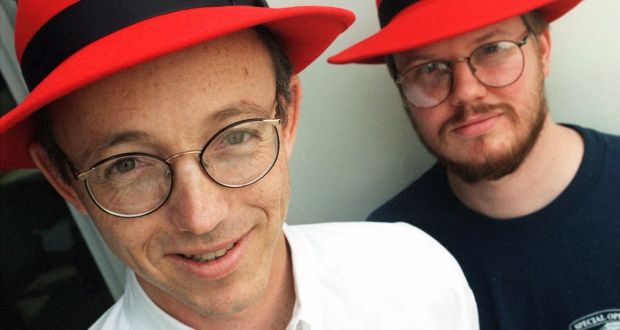Red Hat : The Biggest Linux Distributor & First $1B Open-source Software Company
Founding Red Hat at the time when the market was changing rapidly, was quite a big step, as the co-founders of Red Hat, Marc Ewing and Bob Young followed their gut feeling and kept their ears opened to every good advice from the experts. While building a business model, obviously one should focus on the product that he/she will be building under the name of their business, but at the same time for long term sustainability, one has to be future ready and take the steps carefully.
Founders
Marc Ewing was born on 9 May 1969 and completed his graduate degree from Carnegie Mellon University, in 1992. Ewing was a bright student and was also involved in the 86open project in the mid-1990s in college. His grandfather had gifted him a red colour hat that he used to wear during his college days, and this way, he had become popular as the ‘red hat guy’ in the college.

The co-founder of Red Hat, Bob Young, was a native of Hamilton, Ontario, Canada. He completed his high school from Trinity College School in Port Hope and graduated as Bachelor of Arts from Victoria College at the University of Toronto.
Young, after completing his education, started a computer rental and leasing business and founded Vernon Computer Rentals, in 1984. But in 1990, he sold the company to Greyvest Capital and the money that came from the deal, made him an overnight millionaire. But the good time was not permanent, and he lost his millionaire status just in a few months as a result of some bad business moves from Greyvest Capital.
Young, still, was with Greyvest and to enhance his business he started attending the meetings, where programmers talked about the latest trends in the software program UNIX, running on the servers. He was an outsider but knew that those meetings were the key to his biggest business idea.
At the time Young was attending those meetings, he started a newsletter named New York Unix that had all information about the next meetings. In 1993, after losing his job at Greyvest, he incorporated the newsletter as his another business and founded ACC Corp Inc., which at the beginning was earning from the advertisements. At the same time, Linux was becoming a hot topic as it was free software and many of the companies were choosing Linux over Unix. Eventually, Young started selling Linux software, books and accessories.
Founding Red Hat
At the same time, Young was getting requests from the groups that were subscribed to his newsletter to write more about open source software and Linux. Young, too, was interested in writing about the same but had no idea about what an open-source software was.
He was struggling through the financial crisis, but the Linux based products that he was selling was the main source of his income. So he became more curious about finding more resellers for the Linux products. This led him to reach Marc Ewing, who had set up a little Linux shop in Durham, North Carolina, named as Red Hat.
The company, unmistakably, got its name from the same red hat that he used to wear in college. Marc was working on a Unix project and accidentally, built the first software under Red Hat, in 1994. The project he was working on was to run on a Unix system, but since it was too expensive, he developed the software for Linux.
The evolution of Linux also made Marc interested in the same, and as Linux was an open source software, he started working on fixing Linux.
Finally, on 29 July 1994, he released his first Linux distribution software that was easier to use version over the GPL version. The software became a hit overnight.
Young started officially distributing Red Hat’s software, and after discussing with many Linux experts, Young joined his hands with Ewing to incorporate Acc with Red Hat, and the two turned the co-founders of Red Hat Inc. with a partnership of fifty-fifty.
The two was working passionately for the company, without knowing the real worth of it. In 1999, the company went public, and for their surprise, the company achieved the eighth-biggest first-day gain in the history of Wall Street.
In the same year, Red Hat acquired Cygnus Solutions, followed by the acquisition of the other companies including WireSpeed, C2Net and Hell’s Kitchen Systems, Planning Technologies, Inc., in the later years. In the year 2000, the company won the “Operating System Product of the Year” award for Red Hat Linux 6.1. In 2002, Red Hat introduced Red Hat Linux Advanced Server.
In 2005, Red Hat stock became part of the NASDAQ-100 and, in 2006, Red Hat stock moved from to trading on the New York Stock Exchange (RHT).
In 2012, Red Hat became the first open source software company that entered into the one-billion-dollar group, and in 2015, it surpassed the two-billion-dollar milestone. Just in another three years, in 2018, the company recorded the annual revenue of three-billion-dollar.
On 28 October 2018, IBM announced that it is planning to acquire Red Hat for US$34 billion.
The company headquarter was moved to Raleigh, North Carolina, U.S. from Durham in 2002. As per the 2018 records, the company has raised to 12,600 employees.
Bob Young served as Red Hat’s CEO until 1999, and left the company in 2002, to found his print-on-demand, self-publishing company, Lulu.com. Red Hat is one of the fastest growing companies and one of the pioneers in the open-source software industry.

Yashica is a Software Engineer turned Content Writer, who loves to write on social causes and expertise in writing technical stuff. She loves to watch movies and explore new places. She believes that you need to live once before you die. So experimenting with her life and career choices, she is trying to live her life to the fullest.